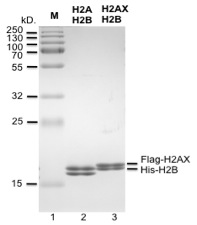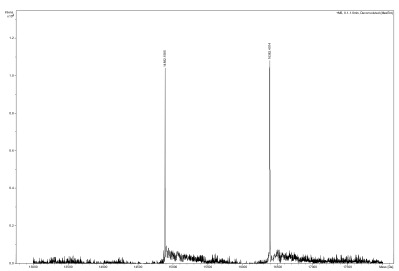|
|
Recombinant Histone H2A.X-H2B dimers
Catalog # : EPX-06-RH
Source : Human
Expressed in : E. Coli
Quantity : 50ug of recombinant H2A.X-H2B dimers at 1ug /ul
Background:
The histone variant H2A.X replaces conventional H2A in a subset of nucleosomes (1). The nucleosome is the basic unit of chromatin and consists of 147 base pairs of DNA wrapped around an octamer of core histones H2A, H2B, H3 and H4 (2). H2A.X plays a central role in DNA repair and chromosomal stability (3). It is required for checkpoint-mediated arrest of cell cycle progression in response to low doses of ionizing radiation and for efficient repair of DNA double strand breaks. H2A.X interacts with numerous proteins required for DNA damage signaling and repair when phosphorylated on Ser-139.
Protein details:
Recombinant human histone H2A.X-H2B dimers were produced in E. Coli as fusion proteins with an N-terminal FLAG or 6xHis epitopes, purified using FPLC and formulated in a storage buffer containing 20mM Tris-Cl pH 7.9, 1mM EDTA, 1M NaCl, 0.5mM PMSF and 1mM DTT. Protein concentration was determined by spectrometry.
Quality control:
Each lot has been evaluated by ESI-TOF analysis and 17% SDS-PAGE mini-gel (Tris-Glycine SDS, Acrylamide-bis (29:1)).
Application Notes:
For research use only.
Storage:
-80°C
Guarantee:
Products guaranteed stable for 2 years from date of receipt when stored properly.
Purity:
>98% purity by SDS PAGE.
Protein sequences: Flag-H2A.X (Theoretical Mw: 16381.81) MDYKDDDDKLESGRGKTGGKARAKAKSRSSRAGLQFPVGRVHRLLRKGHY AERVGAGAPVYLAAVLEYLTAEILELAGNAARDNKKTRIIPRHLQLAIRN DEELNKLLGGVTIAQGGVLPNIQAVLLPKKTSATVGPKAPSGGKKATQAS QEY
6xHis-H2B (Theoretical Mw: 14887.10) MGSHHHHHHGSPEPAKSAPAPKKGSKKAVTKAQKKDGKKRKRSRKESYSI YVYKVLKQVHPDTGISSKAMGIMNSFVNDIFERIAGEASRLAHYNKRSTI TSREIQTAVRLLLPGELAKHAVSEGTKAVTKYTSA
References: 1. Van Holde, K. E. (1989) Chromatin, 1-497. 2. Luger et al., (1997) Nature, 389(6648):251-60. 3. Rogakou et al., (1998). J Biol Chem, 273(10):5858-68. |
|---|
© 2011-2016 EpiGex. All rights reserved



